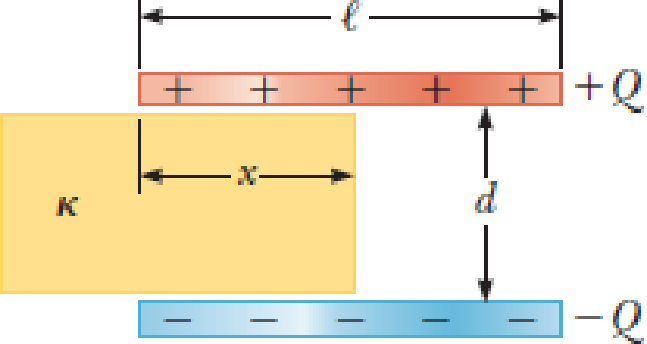
Concept explainers
A capacitor is constructed from two square, metallic plates of sides ℓ and separation d. Charges +Q and −Q are placed on the plates, and the power supply is then removed. A material of dielectric constant K is inserted a distance x into the capacitor as shown in Figure P20.85. Assume d is much smaller than x. (a) Find the equivalent capacitance of the device. (b) Calculate the energy stored in the capacitor. (c) Find the direction and magnitude of the force exerted by the plates on the dielectric. (d) Obtain a numerical value for the force when x = ℓ/2, assuming ℓ = 5.00 cm, d = 2.00 mm, the dielectric is glass (κ = 4.50), and the capacitor was charged to 2.00 × 103 V before the dielectric was inserted. Suggestion: The system can be considered as two capacitors connected in parallel.
Figure P20.85

(a)
The equivalent capacitance of the device.
Answer to Problem 85P
The equivalent capacitance of the device is
Explanation of Solution
Write the expression for the equivalent capacitance.
Here,
Write the expression for the area with dielectrics.
Here,
Write the equation for capacitance by using equation (II).
Here,
Write the expression for the area without dielectrics.
Write the equation for capacitance by using equation (IV).
Conclusion:
Substitute,
Thus, the equivalent capacitance of the device is
(b)
The energy stored in the capacitor.
Answer to Problem 85P
The energy stored in the capacitor is
Explanation of Solution
Write the expression for the stored energy.
Here,
Conclusion:
Substitute,
Thus, the energy stored in the capacitor is
(c)
The direction and the magnitude of the force exerted by the plates on the dielectrics.
Answer to Problem 85P
The direction and the magnitude of the force exerted by the plates on the dielectrics is
Explanation of Solution
Write the expression exerted force.
Conclusion:
Substitute,
For
For
The force is directed along positive x-direction.
Thus, the direction and the magnitude of the force exerted by the plates on the dielectrics is
(d)
The numerical value of force.
Answer to Problem 85P
The numerical value of force is
Explanation of Solution
Write the expression for the area.
Write the expression for the initial capacitance.
Here,
Write the expression for the charge.
Write the expression for the given condition.
Write the expression for the force by using (VI), (VII), (VIII), (IX) and (X).
Conclusion:
Substitute,
Thus, the numerical value of force is
Want to see more full solutions like this?
Chapter 20 Solutions
Principles of Physics: A Calculus-Based Text
- How can i solve this if n1 (refractive index of gas) and n2 (refractive index of plastic) is not known. And the brewsters angle isn't knownarrow_forward2. Consider the situation described in problem 1 where light emerges horizontally from ground level. Take k = 0.0020 m' and no = 1.0001 and find at which horizontal distance, x, the ray reaches a height of y = 1.5 m.arrow_forward2-3. Consider the situation of the reflection of a pulse at the interface of two string described in the previous problem. In addition to the net disturbances being equal at the junction, the slope of the net disturbances must also be equal at the junction at all times. Given that p1 = 4.0 g/m, H2 = 9.0 g/m and Aj = 0.50 cm find 2. A, (Answer: -0.10 cm) and 3. Ay. (Answer: 0.40 cm)please I need to show all work step by step problems 2 and 3arrow_forward
- look at answer show all work step by steparrow_forwardLook at the answer and please show all work step by steparrow_forward3. As a woman, who's eyes are h = 1.5 m above the ground, looks down the road sees a tree with height H = 9.0 m. Below the tree is what appears to be a reflection of the tree. The observation of this apparent reflection gives the illusion of water on the roadway. This effect is commonly called a mirage. Use the results of questions 1 and 2 and the principle of ray reversibility to analyze the diagram below. Assume that light leaving the top of the tree bends toward the horizontal until it just grazes ground level. After that, the ray bends upward eventually reaching the woman's eyes. The woman interprets this incoming light as if it came from an image of the tree. Determine the size, H', of the image. (Answer 8.8 m) please show all work step by steparrow_forward
 Physics for Scientists and Engineers: Foundations...PhysicsISBN:9781133939146Author:Katz, Debora M.Publisher:Cengage Learning
Physics for Scientists and Engineers: Foundations...PhysicsISBN:9781133939146Author:Katz, Debora M.Publisher:Cengage Learning Physics for Scientists and Engineers, Technology ...PhysicsISBN:9781305116399Author:Raymond A. Serway, John W. JewettPublisher:Cengage Learning
Physics for Scientists and Engineers, Technology ...PhysicsISBN:9781305116399Author:Raymond A. Serway, John W. JewettPublisher:Cengage Learning Principles of Physics: A Calculus-Based TextPhysicsISBN:9781133104261Author:Raymond A. Serway, John W. JewettPublisher:Cengage Learning
Principles of Physics: A Calculus-Based TextPhysicsISBN:9781133104261Author:Raymond A. Serway, John W. JewettPublisher:Cengage Learning College PhysicsPhysicsISBN:9781285737027Author:Raymond A. Serway, Chris VuillePublisher:Cengage Learning
College PhysicsPhysicsISBN:9781285737027Author:Raymond A. Serway, Chris VuillePublisher:Cengage Learning College PhysicsPhysicsISBN:9781305952300Author:Raymond A. Serway, Chris VuillePublisher:Cengage Learning
College PhysicsPhysicsISBN:9781305952300Author:Raymond A. Serway, Chris VuillePublisher:Cengage Learning Physics for Scientists and EngineersPhysicsISBN:9781337553278Author:Raymond A. Serway, John W. JewettPublisher:Cengage Learning
Physics for Scientists and EngineersPhysicsISBN:9781337553278Author:Raymond A. Serway, John W. JewettPublisher:Cengage Learning





